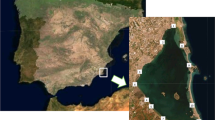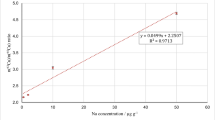Abstract
In order to study the effect of anthropogenic substances on freshwater and marine ecosystems and to develop methods to derive water-quality criteria, ecotoxicological testing is required. While toxicity assessments are traditionally based on dissolved metal concentrations, assuming that toxicity is caused by waterborne metal only, it was recently pointed out that also the dietary exposure route should be carefully considered and interpreted in regulatory assessments of zinc. In this context, the aim of this experimental study was to develop a method which allows the uptake of waterborne and dietary zinc by Daphnia magna and the interaction between both exposure routes to be studied. Therefore, the setup of a dual isotopic tracer study was required. During several days, daphnids were exposed to 67Zn and 68Zn via the dietary and the waterborne routes, respectively, and after several time intervals the daphnids were sampled and subjected to isotopic analysis by means of inductively coupled plasma mass spectrometry (ICP–MS). In order to obtain reliable and accurate results for zinc, special care was taken to prevent contamination and to deal with the spectral interferences traditionally hindering the determination of zinc. The figures of merit of both a quadrupole-based ICP–MS instrument equipped with a dynamic reaction cell, and a sector field ICP–MS unit were studied, and it was concluded that by using a sector field mass spectrometer operated at medium mass resolution all interferences could be overcome adequately. Although the set-up of the exposure experiments seems to be rather simple at first sight, it was shown in this work that several (dynamic) variables can have an influence on the results obtained and on the subsequent data interpretation. The importance of these confounding factors was examined, and on the basis of preliminary calculations it became clear that not only the isotopic composition of the daphnids has to be studied—adequate monitoring of the isotopic composition of the dissolved phase and the algae during the exposure of the daphnids is also required to accurately discriminate between uptake from water and from food.








Similar content being viewed by others
References
Boudou A, Ribeyre F (1989) Aquatic toxicology: fundamental concepts and methodologies. CRC Press, Boca Raton, Florida, USA
Linder M (1991) Nutrition and metabolism of the trace elements. In Linder M (ed) Nutritional biochemistry and metabolism with clinical applications, 2nd edn. Elsevier, New York
Keen C, Taubeneck M, Daston G, Rogers J, Gershwin M (1993) Ann NY Acad Sci 678:37–47
O’Halloran T (1993) Science 261:715–725
Borgmann U, Janssen CR, Blust RJP, Brix KV, Dwyer RL, Erickson RJ, Hare L, Luoma SN, Paquin PR, Roberts CA, Wang W (2005) Incorporation of dietborne metals exposure into regulatory frameworks. In Meyer JS, Adams WJ, Brix KV, Luoma SN, Mount DR, Stubblefield WA, Wood CM (eds) Toxicity of dietborne metals to aquatic organisms. SETAC, Pensacola, Fl, USA, pp 153–189
Wang W, Fisher NS (1999) Environ Toxicol Chem 18:2034–2045
Guan R, Wang WX (2004) Environ Toxicol Chem 23:2689–2698
Meyer JS, Adams WJ, Brix KV, Luoma SN, Mount DR, Stubblefield WA, Wood CM (eds) (2005) Toxicity of dietborne metals to aquatic organisms, SETAC, Pensacola, Fl, USA
De Schamphelaere KAC, Canli M, Van Lierde V, Forrez I, Vanhaecke F, Janssen CR (2004) Aquat Toxicol 70:233–244
De Schamphelaere KAC, Forrez I, Dierckens K, Sorgeloos P, Janssen CR (2007) Aquat Toxicol 81:409–418
Muyssen BTA, De Schamphelaere KAC, Janssen CR (2006) Aquat Toxicol 77:393–401
Kamunde C, Grosell M, Higgs D, Wood CM (2002) J Exp Biol 205:279–290
Croteau MN, Luoma SN (2005) Environ Toxicol Chem 24:2871–2878
Labonne M, Ben Othman D, Luck J (2002) Appl Geochem 17:1351–1360
De Wannemacker G, Ronderos A, Moens L, Vanhaecke F, Bijvelds MJC, Kolar ZI (2001) J Anal At Spectrom 16:581–586
Moens L, Verrept P, Dams R, Greb U, Jung G, Laser B (1994) J Anal At Spectrom 9:1075–1078
Gillis PL, Chow-Frasera P, Ranville JF, Ross PE, Wood CM (2005) Aquat Toxicol 71:143–154
Worms IAM, Parthasarathy N, Wilkinson KJ (2007) Environ Sci Technol 41:4258–4263
Vanhaecke F, Vanhoe H, Dams R, Vandecasteele C (1992) Talanta 39:737–742
Townsend AT, Miller KA, McLean S, Aldous S (1998) J Anal At Spectrom 13:1213–1219
Bohlke JK, de Laeter JR, De Bievre P, Hidaka H, Peiser HS, Rosman KJR, Taylor PDP (2005) J Phys Chem Ref Data 34:57–67
Cowgill UM (1976) Sci Total Environ 6:79–102
Chen K-L, Jiang S-J (2002) Anal Chim Acta 470:223–228
Tanner SD, Baranov VI, Bandura DR (2002) Spectrochim Acta B 57:1361–1452
Townsend AT (2000) J Anal At Spectrom 15:307–314
Riondato J, Vanhaecke F, Moens L, Dams R (2000) J Anal At Spectrom 15:341–345
Acknowledgements
L.I.L. Balcaen and K.A.C. De Schamphelaere are Senior Research Assistants of the Fund for Scientific Research—Flanders (FWO-Vlaanderen). The research was supported by the Ghent University Research Fund (BOF) and two research projects from the FWO-Vlaanderen (G058506 and G004606). Additional support was obtained from the International Lead Zinc Research Organization (ILZRO). The authors wish to thank Leen Van Imp, Emmy Pequeur, Gisèle Bockstael, Jill Van Reybrouck, and Niko Thoen for technical assistance.
Author information
Authors and Affiliations
Corresponding author
Additional information
Lieve I.L. Balcaen and Karel A.C. De Schamphelaere contributed equally to this study
Rights and permissions
About this article
Cite this article
Balcaen, L.I.L., De Schamphelaere, K.A.C., Janssen, C.R. et al. Development of a method for assessing the relative contribution of waterborne and dietary exposure to zinc bioaccumulation in Daphnia magna by using isotopically enriched tracers and ICP–MS detection. Anal Bioanal Chem 390, 555–569 (2008). https://doi.org/10.1007/s00216-007-1620-5
Received:
Revised:
Accepted:
Published:
Issue Date:
DOI: https://doi.org/10.1007/s00216-007-1620-5




